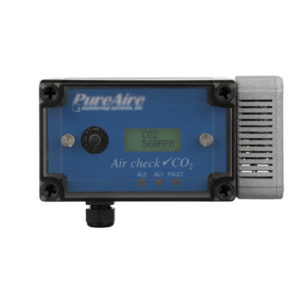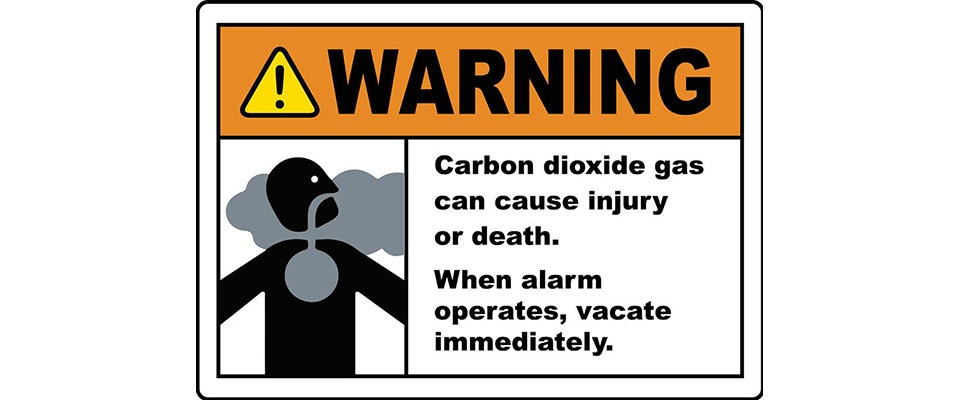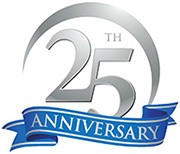Carbon Dioxide Safety – Why It’s Important to Monitor Carbon Dioxide
- By : PureAire Monitoring Systems
- Posted on : August 19, 2021
- News Room
What is Carbon Dioxide?
Carbon dioxide is the fourth most abundant gas in the earth’s atmosphere after nitrogen, oxygen, and argon. At room temperature, carbon dioxide (CO2) is a colorless, odorless, non-flammable gas, but at different temperatures and pressures, carbon dioxide can be a liquid or a solid (i.e., dry ice).
Carbon dioxide is produced when fossil fuels are burned, or as vegetation decays. CO2is also generated as a by-product in certain manufacturing processes, such as during the fermentation stages when making beer and wine. All living beings exhale CO2 as a normal part of the respiration process, and plants require CO2 for photosynthesis to take place.
Carbon dioxide displaces or depletes oxygen and, at unsafe levels, can cause dizziness, confusion, headache, shortness of breath, unconsciousness, and even death due to asphyxiation. Carbon dioxide may accumulate in confined spaces, causing health and safety hazards.
What is a Carbon Dioxide Monitor?
A carbon dioxide monitor is used to track carbon dioxide levels in targeted areas. Monitors are used to verify that carbon dioxide levels are within a range sufficient to ensure the safety of occupants within the tested areas. CO2 monitors are programmed to alert personnel when CO2 levels reach an unsafe threshold.
Additionally, CO2 monitors may be used in greenhouses or grow rooms to ensure that appropriate concentrations of carbon dioxide are maintained to yield healthy crops. Increased carbon dioxide levels stimulate the photosynthesis process, resulting in stronger and faster-growing plants, but the levels must be monitored closely, as too much CO2 can damage plants, as well as present health risks to employees.
The Occupational Safety and Health Administration (OSHA) has established a permissible exposure limit (PEL) for CO2 of 5,000 parts per million (ppm) averaged over an 8-hour workday (time-weighted average or TWA).
The National Fire Protection Association (NFPA) code 13.7.2 stipulates that rooms or areas where CO2 container systems are filled and used indoors or in enclosed outdoor locations shall be provided with a gas detection and alarm system capable of detecting and notifying the building occupants of a gas release or carbon dioxide levels above the OSHA PEL of 5,000 ppm. Additionally, NFPA specifies that the gas detection system must be capable of initiating an audible alarm within the room or area in which the system is installed.
Industry Applications
Carbon dioxide monitors are designed for use in a wide range of applications, such as the food and beverage industry (breweries, wineries, bottling plants, bars and restaurants, food processing, and frozen food production facilities), laboratories, universities, pharmaceutical manufacturing, agricultural locations, schools, and office buildings.
Bars, restaurants, and fast-food establishments all rely on CO2 to carbonate beverages such as soda and beer and, as such, all require the use of CO2 monitors.
Pharmaceutical manufacturers use carbon dioxide to purge oxygen from packaging, not only to maintain a sterile environment but also to protect products during transport, and to prolong the stability and shelf life of the packaged drugs. Additionally, dry ice (the frozen form of carbon dioxide), is used to keep temperature-sensitive medicines at required cold temperatures.
A diverse array of indoor gathering places, including office buildings, schools, and retail locations, monitor carbon dioxide levels to measure indoor air quality and ensure that safe oxygen levels are maintained. Building HVAC systems may be programmed to activate their ventilation systems to recirculate and refresh the air in response to elevated CO2 levels.
PureAire Carbon Dioxide Monitors
PureAire’s Carbon Dioxide Monitor offers thorough air monitoring, with no time-consuming maintenance or calibration required. Air quality measurements are taken every 2 seconds and are visible on the Monitor’s easy-to-read backlit display. In the event of a rise in CO2 levels to an OSHA action level, the Monitor will set off an alarm, complete with horns and flashing lights, alerting personnel to evacuate the affected area.
offers thorough air monitoring, with no time-consuming maintenance or calibration required. Air quality measurements are taken every 2 seconds and are visible on the Monitor’s easy-to-read backlit display. In the event of a rise in CO2 levels to an OSHA action level, the Monitor will set off an alarm, complete with horns and flashing lights, alerting personnel to evacuate the affected area.
In certain applications, including inside greenhouses and grow rooms, the CO2 alarm can be set to maintain desired CO2 levels, and can be programmed to go off when CO2 levels change.
PureAire’s Monitor can be linked to a Programmable Logic Controller (PLC), a multi-channel controller, a remote display, or tied into building HVAC systems themselves.
Our Carbon Dioxide Monitor includes an NDIR sensor cell to reliably measure CO2 levels. The monitor will remain accurate over a wide range of temperatures (0-50°Celsius) and humidity levels (0-95%RH), as well as changes in barometric pressure.
Where Should Carbon Dioxide Monitors Be Installed?
The specific application will determine where best to install a PureAire CO2 Monitor. For example, bars and restaurants serving carbonated beverages should install a Monitor 12-18 inches off the floor in areas where compressed CO2 is stored or used.
For applications that require high concentrations of CO2, such as inside greenhouses and grow rooms, the Monitor may be mounted inside the room, with employees utilizing a remote display located on the outside for at-a-glance visibility.
To ensure safety, PureAire generally recommends installing one monitor for approximately every 400 square feet of your facility’s space. However, since airflow can be unpredictable, we encourage you to contact PureAire for additional guidance specific to your needs.



